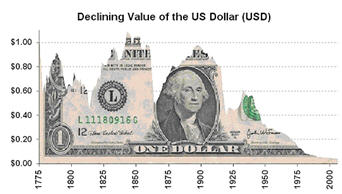Greek default, Eurozone/bank crisis and the effect on the gold, silver prices
 We agree with Professor Rogoff that Greece should have defaulted some time ago. Despite all the current efforts, Greece will default and that contagion will result in a global, banking crisis. Even if we’re wrong, the mountains of money that will be created and poured into the debt hole will benefit the gold and silver prices. The Greek debt crisis is about stemming the spread of bank runs, the breakdown of the other PIIGS countries debt situation, and potentially the fragmentation of the Eurozone. We’re on the brink.
We agree with Professor Rogoff that Greece should have defaulted some time ago. Despite all the current efforts, Greece will default and that contagion will result in a global, banking crisis. Even if we’re wrong, the mountains of money that will be created and poured into the debt hole will benefit the gold and silver prices. The Greek debt crisis is about stemming the spread of bank runs, the breakdown of the other PIIGS countries debt situation, and potentially the fragmentation of the Eurozone. We’re on the brink.
In the last week, we have seen global market confidence buckle in the face of slowing growth and what may already be a recession. This is not the time that poorer nations can use falling cash flow to repay mountains of debt. Talk of a 50% haircut on Greek debt should be lifted to as high as 60% to 70% for the Greeks to be able to manage its remaining debt in light of future, Greek cash flows.
To get a handle on the Eurozone debt crisis we have to imagine that each nation is an individual. If an individual is bankrupt an offer of compromise is made that usually is 50% for the debt to be written off. It’s not a ‘haircut’ of 50% of the debt with the remaining balance to still be repaid. But such a haircut is a ‘managed default’. The banks that have to take a haircut see their balance sheets drop by this amount, often making the ratios by which it has to maintain too. This reduces the amount it can lend and often puts it in a dubious financial position, bringing its own creditors down upon it. With the global banking system so interwoven, the spread of such fears reaches far and wide. We saw this last week in the downgrade of Societe Generale and Credit Agricole, two of France’s largest banks, because of their exposure to Greek debt. If the Eurozone crisis finds other nations following Greece, then expect much more of this type of downgrade.
What’s happening to Confidence in Currencies?
At this stage it doesn’t matter which way the crises go. Confidence has fallen worldwide in government debt situations and the banking industry, with fears of more to come. The very fact that the developed world is in the financial state it is, has caused the fall in confidence. If the Greek situation leads to a convincing bailout, the weaknesses in the Eurozone will still remain. Confidence in the euro has fallen and won’t return to the previous year’s levels. With money fleeing the Eurozone, it only found the dollar as an alternative. The Swiss Franc and the Yen have ceased to be safe-havens because their central banks have intervened to weaken those currencies. This left the ‘tree trunk’ of the currency system, the U.S. dollar, as the only really liquid place to go. This was not because of any value that could be retrieved, but because it’s the only remaining currency that remains standing under pressure. Right now the euro is gaining against it, as the world hopes that Greece will get a sufficient bailout. But tomorrow it could weaken again. As to the dollar, its debt crisis is more severe, but not as immediate.
Now stand back a pace and ask…
“Can we have confidence in the value of the Dollar, the Euro, the Yen, the Swiss Franc or the British Pound?”
We all appreciate that their values have fallen, but we have to use them as the only available way of paying for things. Do we believe that the governments of these countries are capable of restoring any inherent value in these currencies? Are their structures and that of national balance sheets solid enough to want us to hold our wealth in them? If your answer was not as positive as it was four years ago, you have a measure of how their values have suffered. Looking forward, do you believe that your confidence in these stores of wealth will grow to the extent you want to hold them, or will you do so with a careful eye on them, preferring an alternative, but not being so certain where to go?
What has floated to the top of national priorities for currencies is a global need to have international prices –for the exports of goods from those nations—retain their global competitiveness. This means a persistent weakening with the rest of the world’s currencies following the weakest. In itself this guarantees dropping values for all global currencies. There’s nothing to be gained through a strong currency over time. This structural shape of currencies is not likely to change. In fact, it’s likely to produce more and more financial discord in foreign exchanges. Price competition through exchange rates has to destroy value slowly, but surely.
Debt and Bank Crises
We may be tempted to see the debt crises as a short-term problem, but as the world’s leaders agree, they’re scaring the world and threatening global financial stability. So this isn’t a case of the passing flu; it describes a congenital weakness that needs a structural solution. Nowhere can we see evidence of structural reforms likely to shore up confidence and repair the global financial system. The system is flawed and most expect such crises to persist for the foreseeable future.
So why not just write off the entire world’s toxic debt, print the equivalent amount of money to fill the holes and start all over again? After all if you look back at the Fed’s QE exercise, doesn’t that amount to the same thing? Well, almost. Now add to that a good dose of inflation, and debt diminishes in value and asset values rise. Well, that would destroy all confidence in the Capitalist system and money itself, wouldn’t it? No, the world is locked into resolving these problems and ensuring the continued working of the global economy in such a way as to retain confidence. We’ve not seen such a dire financial scene since the Second World War, (according to the outgoing head of the European Central Bank) and close to the scene seen in the early 1930s. Then the answer was to massively expand the global money supply, through the devaluation of the U.S. dollar against gold by 75%.
We have no doubt in our minds that the global, financial authorities want a similar expansion of money for the purpose of diminishing the impact of the current crises. But they have to do it in such a way as to convince people everywhere that the system remains viable and healthy, despite such a debauching of money. They cannot do it without convincing people that money has become cheaper and less reliable. This favors precious metals.
Effect on Gold, Silver Prices
Investors were shocked when gold dropped from $1,850 to below $1,600 in an almost straight line. When they saw silver drop from $40 to $28 they were even more shocked. After all, since 2005 gold has come from $300+ and silver from $6+, so a $250 drop and a $12 drop seemed to be huge. Since then we have seen the silver price recover $4 in one day and the gold price $60 in a day, with more recovery to come. In percentage terms, when compared to other markets, we see similar falls there and in similar percentages, but not the same vigor in recovery. The big picture confirms that falls, in most markets, were investors raising liquidity to lower leverage and protect against the falls, just as we saw in 2008. This is something market observers cannot see ahead of time. They accompany major shifts in investor perceptions about the structure of global financial markets.
Just as we saw in 2009 and onwards, the loss of confidence in global financial markets doesn’t recover. In the gold market, since the pullback from $1,200 to $1,000, we’ve seen gold rise to $1,910 and silver to mid-$40 area, a tremendous gain since then. What’s there to prevent a similar shape to the precious metal markets going forward?
Take a look at the function of gold and silver. Gold, in particular, is an international asset and international cash. It can be used when all else fails. We saw that in the recent falls. Investors could liquidate holdings quickly and take good profits to cover losses, loans, and margin calls in other markets. Once there’s a moderate stabilizing of markets, that lesson is remembered. Investment house strategists factor that into their policy decisions, realizing that in bad times, future profits lie in precious metals.
In the emerging world, the fall in precious metal prices is seen as speculators getting out of the market and giving them an opportunity to buy at prices they feel will allow for certain rises. Their faith in gold and silver remains completely unshaken by the falls, which they see as part of the ongoing suspicions about the developed world banking system and markets speculation. To them the value of gold and silver remains untouched and certain. Falls are seen as an opportunity to buy cheaply into the precious metals.
Member’s Only
Can Investors Trust Gold, Silver Again?
Will Precious Metal Prices Recover?
Get the rest of the report.
Subscribe @ www.GoldForecaster.com www.SilverForecaster.com
Legal Notice / Disclaimer
This document is not and should not be construed as an offer to sell or the solicitation of an offer to purchase or subscribe for any investment. Gold Forecaster – Global Watch / Julian D. W. Phillips / Peter Spina, have based this document on information obtained from sources it believes to be reliable but which it has not independently verified; Gold Forecaster – Global Watch / Julian D. W. Phillips / Peter Spina make no guarantee, representation or warranty and accepts no responsibility or liability as to its accuracy or completeness. Expressions of opinion are those of Gold Forecaster – Global Watch / Julian D. W. Phillips / Peter Spina only and are subject to change without notice. Gold Forecaster – Global Watch / Julian D. W. Phillips / Peter Spina assume no warranty, liability or guarantee for the current relevance, correctness or completeness of any information provided within this Report and will not be held liable for the consequence of reliance upon any opinion or statement contained herein or any omission. Furthermore, we assume no liability for any direct or indirect loss or damage or, in particular, for lost profit, which you may incur as a result of the use and existence of the information, provided within this Report.
{{ commodity.name }}
{{ post.title }}
{{ post.date }}



Comments